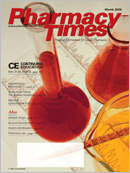Publication
Article
Pharmacy Times
BioMarin's Naglazyme (galsulfase)
Author(s):
The US FDA has approved BioMarin'sNaglazyme (galsulfase) for the treatmentof mucopolysaccharidosis VI (MPS VI). Asthe first drug approved for treatment ofMPS VI, Naglazyme earns orphan drugstatus and 7 years of exclusivity on themarket.1 Its use has been shown toincrease walking and stair-climbing abilityin patients diagnosed with MPS VI.2
MPS VI, a genetic disorder that occursfrom a deficiency of the lysosomalenzyme N-acetylgalactosamine 4-sulfatase,affects approximately 1100 peoplein the world.1,3 Patients with MPS VI cannotbreak down certain complex carbohydrates,such as glycosaminoglycans(GAGs). As a result, the GAG substrateand carbohydrate residues collect in thecells' lysosomes, leading to dysfunctionof the body's cells, tissues, and organs.3,4Symptoms of MPS VI include decelerationof growth, liver and spleen enlargement,deformities of the joints and skeleton,and upper airway obstruction. Initialdiagnosis is usually made between 6 and24 months of age, and life expectancy foran MPS VI patient is 20 to 30 years.3
Pharmacology
Naglazyme acts as an exogenousreplacement for the enzyme that is missingin patients with MPS VI, leading toincreased breakdown of GAGs anddecreased lysosomal accumulation.1,4
Clinical Trials
A total of 56 patients with MPS VI participatedin Naglazyme clinical trials. Arandomized, double-blind, multicenter,placebo-controlled clinical trial involved39 patients aged 5 to 29 years who wereable to walk 5 to 400 meters in 12 minutes.Patients were randomized to receiveeither Naglazyme 1 mg/kg or placebofor 24 weeks. The Naglazyme groupshowed a significant increase in distancewalked during 12 minutes and the rate ofstair-climbing over a 3-minute period.Additionally, decreased urinary GAGswere noted in the Naglazyme group.
Following the double-blind period, anopen-label study evaluated 38 patientsreceiving Naglazyme for 24 weeks. Anincrease in distance walked and stairclimbingability was observed in bothgroups.
An additional 17 patients were enrolledin 2 more studies. Treatment withNaglazyme lasted for up to 144 weeks.Baseline demographics, disease progression,and urinary GAG levels were similarto the randomized trial.4
Dosing and Administration
Naglazyme is a once-a-week intravenousinfusion of 1 mg/kg. Each singledoseNaglazyme vial contains 5 mg; thetotal dose should be mixed in 0.9% sodiumchloride injection, USP, and broughtto a final volume of 250 mL. The doseshould be infused over at least 4 hours,with an initial rate of 6 mL/h for the firsthour and a maximum rate of 80 mL/h forthe remaining 3 hours. If needed, thedose may be infused over up to 20 hours.
Patients weighing less than 20 kg andat risk for fluid overload may receive theirdose in 100 mL of diluent; in this case,the total rate should be adjusted so thatthe infusion time is at least 4 hours.
Naglazyme should be administeredwith a polyvinyl chloride infusion setand an in-line, low-protein-binding 0.2micrometer filter. The safety ofNaglazyme in glass containers has notbeen studied.4
Adverse Effects
Naglazyme has beenassociated with an infusionreaction, whichwas the most commonadverse reaction requiringintervention. Premedicationwith an antihistamineand/or antipyretics30 to 60 minutesprior to the infusionis strongly recommended,and vital signsshould be monitoredthroughout the infusion.The most common infusionreactions werefever, chill, rigors,headache, rash, and urticaria. Severeinfusion reaction symptoms includedangioneurotic edema, hypotension,bronchospasm, respiratory distress, andapnea.2 Other adverse effects includedheadache, fever, arthralgia, vomiting,upper respiratory infections, abdominalpain, diarrhea, ear pain, cough, and otitismedia.4
Dr. Holmberg is a pharmacist withPhoenix Children's Hospital, Phoenix,Ariz.
For a list of references, send astamped, self-addressed envelope to:References Department, Attn. A. Stahl,Pharmacy Times, 241 Forsgate Drive,Jamesburg, NJ 08831; or send an e-mailrequest to: [email protected].

Newsletter
Stay informed on drug updates, treatment guidelines, and pharmacy practice trends—subscribe to Pharmacy Times for weekly clinical insights.






